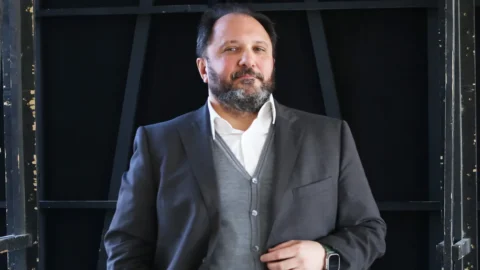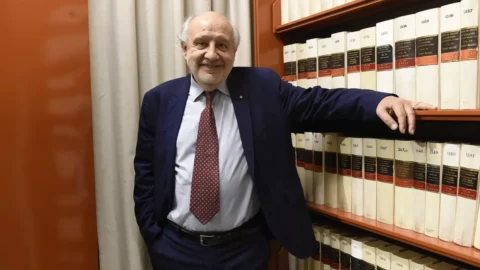July 1, 2020 is very close but the 19 million electricity customers who still feel guaranteed by the so-called Greater Protection, i.e. by the administered bill regime, need not fear. There won't be a D-day where, all of a sudden, everyone has to switch to the free market. But it is desirable, also in their interest, that there are no new postponements. He states it in this interview with FIRSTonline, Stefano Besseghini, president of Arera, the authority that supervises our electricity and gas bills as well as the water sector and waste. It is with him that we try to understand what awaits us and what innovations the new Board of the Authority will bring about a year ago when it entered into full function.
The moment is not easy: energy is going through an epochal transition towards renewable sources but the market still needs gas to stabilize the system. Infrastructures are at the center of interest of the Arera because only with infrastructures up to the needs of Italians - Besseghini tells us - can adequate and homogeneous services be obtained throughout the national territory: and if the issue is less alarming for electricity and gas, the gap on water and waste is sensational. Besseghini's message, which he held a few days ago its annual report, wants to be pragmatic and reassuring.
And while the government majority is divided on the nationalization of water - yes or no - the Arera explains that the regulation implemented up to now by the Authority has led, in the last 7 years, a growth in investments (recognized in the tariff and supervised) from 1 billion to triple, with the rate of effective construction of the plants rising from 50 to 80 percent. And where local realities still operate outside the regulation? At stake for the next four years are 9 billion in investments covered by tariffs and another 3, approximately, covered by public funds.
What to do? The door is open: ok to public funds, but nothing prevents them from being redirected to achieve the goals set by the regulation. Which then means monitoring investments, even if public, so that they are completed. In short, the world of services is varied, ARERA seems to say, better a mediation with "a flexible and asymmetrical system", if needed, than a revolution with an uncertain outcome.
President Besseghini, let's start with electricity. The deadline of 1 July 2020 is near and 19 million customers are still tied to the Authority's tariffs. It has been calculated that it would take ten years, at this rate, for a complete migration to the free market. What can the Authority concretely do to facilitate this transition?
“We must not forget that 2020 is not year zero. We are already in a context where the free market exists and consumers can freely decide between multiple offers on the market. The offer portal, the consumption portal, the approved offers, the regulation of purchasing groups, are tools that offer a non-economic protection network that can be developed and increased. This could also have a boost on the inertial size of the market. Nothing prevents us from imagining that while the mechanism is structured, it is enriched with information, people focus on the opportunities and even the operators manage to take an extra step in terms of clarity of the offer, the migration rate can increase and the times shrink".
Many consumers still seem unprepared. The government is late and has not issued the decree which must indicate how to carry out the transition to full liberalisation. Isn't there a risk of crashing?
“The fact is that starting from such high numbers just one year from the deadline, you don't have to be a great strategist to imagine that we could find ourselves in a non-optimal situation. For this reason we think it is preferable to imagine that 2020 - avoiding new postponements - is a path, a further step towards overcoming the Protection, consistently outlining the subsequent steps. There is no road map yet defined. But this is the time to think about it and prepare it”.
What are the advantages of full liberalization in your opinion? They are not yet completely clear in terms of price and services…
“The market is evolving, it is a perspective that is being built day by day, as has already happened for telephony on the other hand. Looking at today, there are spaces on the free market to find even economically convenient offers and 55% of users who have already left the Tutela demonstrates that the market is able to express elements of convenience. Up to now, 86-87% of the choices of consumers who pass on the free market are oriented by the price, which is fixed and stable over time.
This path can be enriched on two fronts: on the one hand with not only economic but service components; on the other, making sure that the seriousness perceived by the user is strengthened. Salespeople should try to implement strategies that free them from the aggressive approach to the customer as a major component of the commercial strategy. The Authority sanctions and intervenes to put the necessary limits on these phenomena when they degenerate, but operators can also bring some "order" within them, trying to limit those practices - such as those entrusted to external structures that aim to maximize finalized contracts – and shifting the attention to behaviors aimed at maintaining and retaining the customer over time”.
On the other hand, what are the problems that would arise if deferring liberalisation?
“From a structural point of view, the electricity sector, in general, is moving towards paths of ever greater liberalization also upstream: with distributed generation, with extra services and not just energy supply, with free and diversified aggregations of consumers . All of this is in contradiction with maintaining a protection mechanism based on the quarterly update of tariffs. In addition to this, there is also an operational aspect. Wholesale markets are evolving and showing greater dynamism: it would be a paradox if it weren't exploited, quickly transferring the advantage to the final consumer.
Finally, the structure of the system: I have no way of demonstrating it but this proliferation of sellers, which we are witnessing, probably also has its reason in the uncertainty of the moment. Since there is still no clear definition of the exit path from the Protection, the impression is that entry on the market is considered as a useful move to be at the starting point at the right moment. And this does not favor aggregations and market rationalization processes. In the case of gas, for example, operators are slowly decreasing and now we are just over 400: the process of convergence has taken place and we will try to intensify it further”.
Italy suffers from insufficient infrastructure and a strong gap in the quality of services in the area, President Mattarella and you yourself have drawn attention to this point in your annual report. How can this gap be addressed?
“Certainly the quality of the service largely depends on the infrastructural availability.
In the electricity sector, for example, the issue is linked to the distribution sector. In 2017-18 we saw a worsening of outages, a small sign, nothing alarming, but better addressed now. As? With the mechanism based on bonuses/penalties, it is possible to work towards greater attention on the part of distributors to reduce interruptions or accelerate the improvement programs already underway.
In the water sector, the renewal of pipes is an important indicator: we are witnessing a progressive increase in investments covered by the tariff, with an implementation rate of the interventions that has gone from 50 to 80 percent. Spending on water investments amounted to 3,5 billion in 2018 and 3,4 billion in 2019 with a +14% of the amount covered by the tariff compared to that initially planned. We will continue to monitor the implementation of the investment plans.
However, these interventions concern areas in which the regulation works: there is the operator, there are the governing bodies of the area (Ato), there are the governance mechanisms that have made it possible to align the manager's activity with the wishes of the regulation. Unfortunately there are areas of the country where, especially in the South, this model is not yet implemented correctly. On the one hand, we need the regulation prepared by Arera to be fully applied, and on the other, the possibility of intervening with non-repayable public funds".
A double track, basically. How do you move in these situations?
“For a year now we have also intensified our attention on these public investment mechanisms, trying to create a virtuous agreement with the entities concerned. Off-tariff public investment is fine, but we try to involve local realities in a process of progressive achievement of Arera's regulatory objectives".
In short, the Authority follows a line of mediation. Your vision on water regulation seems to go in a different direction from the one that Parliament seems to have taken with the reform wanted by the M5S (less by the League) which wants to bring the powers back to the Ministry of the Environment and return to a "nationalization" of the waterfall. How can they be reconciled?
“Parliament is sovereign and the law it approves will override the regulation of the Authority, of course. Our indication, while waiting for the House and the Senate to take their own steps, is that in the last 6-7 years the sector has made important steps forward, investments have recovered, operators are joining forces. We already pointed out in the hearing to the Environment Committee that the sector can benefit from good maintenance rather than a revolution. A large audience of operators and stakeholders in the hearing confirmed that the current regulatory mechanism has brought stability. In the areas where action is still needed, a flexible and even asymmetrical approach can be aimed at, but within a clear and defined path also for the public manager where it is present”.
In terms of infrastructure, the other "leg" is that of waste, with the disasters we have before our eyes in Rome.
“Arera's experience in the waste sector is in its infancy, as the new skills arrived last year. We are faced with two aspects: on the one hand, governance which is very varied and we verify this even now in the ongoing discussion between the Lazio Region and the Municipality of Rome where a serious crisis is being faced. The Authority is available to give its contribution to build more clearly the governance models to be adopted.
The other aspect is the situation of the plants, and here we return to the infrastructure theme: There is a need to complete the recycling process. The same operators have indicated that the stability of the regulation on the return on investments is an important factor. But everyone underlined that the biggest problem to face is that of the level of acceptance of the plants to be built by the residents. For this reason we plan to include in the tariff also the expenses to be faced for information campaigns for citizens, to improve transparency and promote acceptability. I'm not sure the Authority can do it alone, but we'll do our best."
Undoubtedly it is difficult to support the need to make investments to overcome emergencies, improve the quality of the service, encourage mergers between managers and create the dimensions necessary to promote efficient spending, when local governments blow against it and the central government itself is split on these issues. Can the path of cost and performance comparisons encourage a virtuous mechanism?
"The regolation sunshine, especially when there is no market competition but for the market, helps to make the elements of comparability between territories visible, also taking into account the complexities that exist: it is clear that waste collection in a mountain village cannot be compared with that of a large urban agglomeration. But these are technicalities that can be resolved. The important thing is to set in motion a virtuous mechanism. We will start with the water sector, for the waste sector we are still at the beginning and it seems premature to me to talk about comparability now, but we will get there. Meanwhile, a few days ago we gave an initial acceleration to have the first tariff method by the end of the year and setting the times to allow Local Authorities and environmental services managers to include the method in the financial plans of the next TARI, with effect from January 2020 ".






Besseghini's answers, at least risky.
Besseghini: "the regulation implemented up to now by the Authority has led, in the last 7 years, to a growth in investments (recognised in the tariff and supervised) from 1 billion to triple".
Observation: the growth of investments in the electricity sector is heavily paid for by users, especially the weakest.
A single, a pensioner with low income in energy austerity (1200 kWh/year) today has an average cost of electricity of 0,241 €/kWh (2nd quarter 2019 Protection). Ten years ago (2nd quarter 2009 Tutela) it paid €0,156/kWh. A 54% increase in ten years. All loaded on the items "transport and management", "system charges", "taxes and VAT". The cost of energy alone instead fell, but the outcome on the wallet was the opposite.
The fixed costs (excise duty and VAT included) for a resident are today €145/year: 50% of the total bill for the 1200 kWh/year pensioner. In 2009 it was €33/year. 430% increase in absolute value.
The responsibility for all this also belongs to ARERA.
For comparison: what would we say if they started asking us for fixed costs at the petrol pump? “I made 15 euros”. Answer: "Good, it's 20, 15 + 5 fixed cost". "Why?". “Well, you know… cost of personnel, renewal of pumps, wear and tear of services, maintenance, …”.
Why would we find this inadmissible, while we are silent about electricity?
Besseghini: "..the context in which the free market exists and consumers can decide freely... The offer portal, the consumption portal, the offers accepted,... are tools that offer a protection network"
Wrong.
The offer portal does not allow you to check the annual price totals displayed for the individual offers. Because the Portal does not indicate which energy price is used. And it is not indicated on which of the items that add up to the total "network losses" apply or not. The user seems deliberately left in the dark about the mechanisms that contribute to the formation of the final price. Do not tell me that the document "Rules for calculating estimated annual expenditure" (55 pages) is understandable.
Is this clarity? Is this tool and consumer protection?
For comparison: who would accept an estimate from a craftsman or a professional without unit prices?
The Offers Portal does not check the truthfulness of the individual offers, which are entered by the operators themselves, who are solely responsible (read the "legal information" page of the Portal, at the colophon on the home page).
The estimated annual electricity expenditure is actually "trine". Once an electricity offer and a user's consumption profile have been fixed, we have:
An "estimated annual expenditure" amount on the Portal.
An amount on the obligatory "comparability sheet", different from that of the Portal also by adding the "pieces" that are missing, i.e. taxes and VAT.
An amount of the technical-economic conditions in the contract.
These three amounts often don't match up. A control and standardization mechanism should be established between them. Instead, the Portal doesn't even have a feedback form with which a user can report anomalies and inconsistencies.
To paraphrase on the contrary: “Consumers can decide freely… but to date they decide not to decide. And they do well, given the confusion that reigns.”
Let's move on to the Consumer Portal. What is the use of this additional portal for the user if the total annual consumption is already on the bills? That is the only data that contributes to cost estimates. Certainly not the quarter-hourly readings of the Consumer Portal.
Besseghini: “There is no road map already defined.”
Put simply: the Government decided some time ago that protection should end in 2020. It has not decided on the treatment to be reserved for the most vulnerable. For example, the elderly who don't know what to do and who (if not already ensnared by unscrupulous sellers) will remain protected until the end.
Will coercive measures be needed? There is to feel like a passenger on the Sea Watch. But there is no brave commander here.
Besseghini: “The market is evolving…it is being built day by day, as has already happened for telephony”. And again: “There are spaces on the free market to find even economically convenient offers”.
Note: Electricity and telephone are not related. Mobile telephony has required large initial investments and now has marginal and stable operating costs, hence the collapse in prices. The electricity market is highly fickle, subject to meteorological and geopolitical vagaries. So much so that some operators fail. The electricity network is unique (as opposed to telephony where everyone has their own lines and repeaters). The electricity grid must supply the power at any moment which is absorbed in the same instant by the sum of all the users. Neither more nor less. Which means "turning on and off" plants at a rapid pace. Or stop part of the wind power if there is overproduction at a given moment. Operators' room for maneuver is limited. Just as the convenience of the free market is reduced with respect to protection, which has never set itself the goal of generating operating profits.
Let's not expect the miracles of low-cost telephony for electricity, because there won't be any.